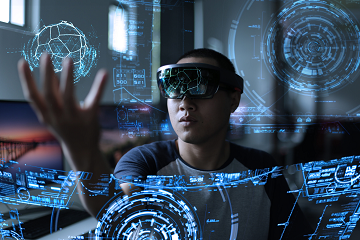
Story Outline
Whether it is healthcare, retail, social media or the workplace, the metaverse has the potential to change lives. With the increase in popularity of virtual reality, augmented reality and mixed reality, the metaverse is gaining momentum, enabling users to go about a normal conversation as an avatar in a ‘different world’.
But according to a report by the World Economic Forum, the true benefits of the metaverse do not come from the creation of new digital worlds. They come through the integration of physical and digital worlds.
1. Meeting the Metaverse Challenge: AR Emerges as a Key Enabler for the Future.

To learn more about this report Download a Free Sample Report
The move to the metaverse will require enormously sophisticated future technologies. According to Intel, to power the metaverse for hundreds of millions of users simultaneously, the world’s current computing, storage and networking infrastructure is ‘simply not enough’. A key to the success of the metaverse includes integrating the physical and the digital, with AR representing a better fit ‘for the real world’.
“Platforms for the metaverse typically either use AR or VR,” she writes. “VR has come to life over the past decade through gaming, esports, and entertainment, with fully virtual avatars and environments. On the other hand, AR is a better fit for work in the real world. While there’s room for both in the growing metaverse market, AR ultimately has the greatest potential. With AR, you can still interact with the objects, tools, environments, and people around you – making adoption easier, providing greater value to existing activities and speeding the path to ROI. Plus, this paradigm feels more natural and intuitive, since human evolution has equipped us to interact this way.
2. Building an open, interoperable metaverse ecosystem for the world

Visit this Link: – Request For Custom Report
Last year Microsoft, Epic Games, Meta, and 33 other companies and organisations announced the formation of a standards group for metaverse technology. “Building a metaverse for everyone will require an industry-wide focus on common standards,” said Vishal Shah, Vice President of Metaverse at Meta. “The Metaverse Standards Forum can drive the collaboration that’s needed to make this possible, and Meta is committed to this work. Creators, developers and companies will all benefit from the technologies and experiences that will be made possible by common protocols.”
The Khronos Group hosts the Metaverse Standards Forum, inviting any company, standards organization, or university to participate without any fees through a Participant Agreement. Emphasizing the significance of open standards, Johnson highlighted how they facilitate collaboration among developers, hardware manufacturers, MDMs, and partners, accelerating adoption, fostering innovation, and allowing users to determine the most suitable solutions. While closed ecosystems may have specific applications or business models, they are better suited as distinct “islands” within the broader metaverse ecosystem.
Companies have already begun to adopt the metaverse, with Microsoft and Samsung owning 158 and 122 patents on the metaverse respectively. As Johnson describes, enterprises are primed to pioneer advances in the metaverse, just as they did for mainframe computing. Enterprises are leading the way because they understand the case for productivity, competitive advantage and value to their customers.
The post AR the future of metaverse: Global Market to reach USD 700 Mn by 2028?: Ken Research appeared first on Ken Research.








